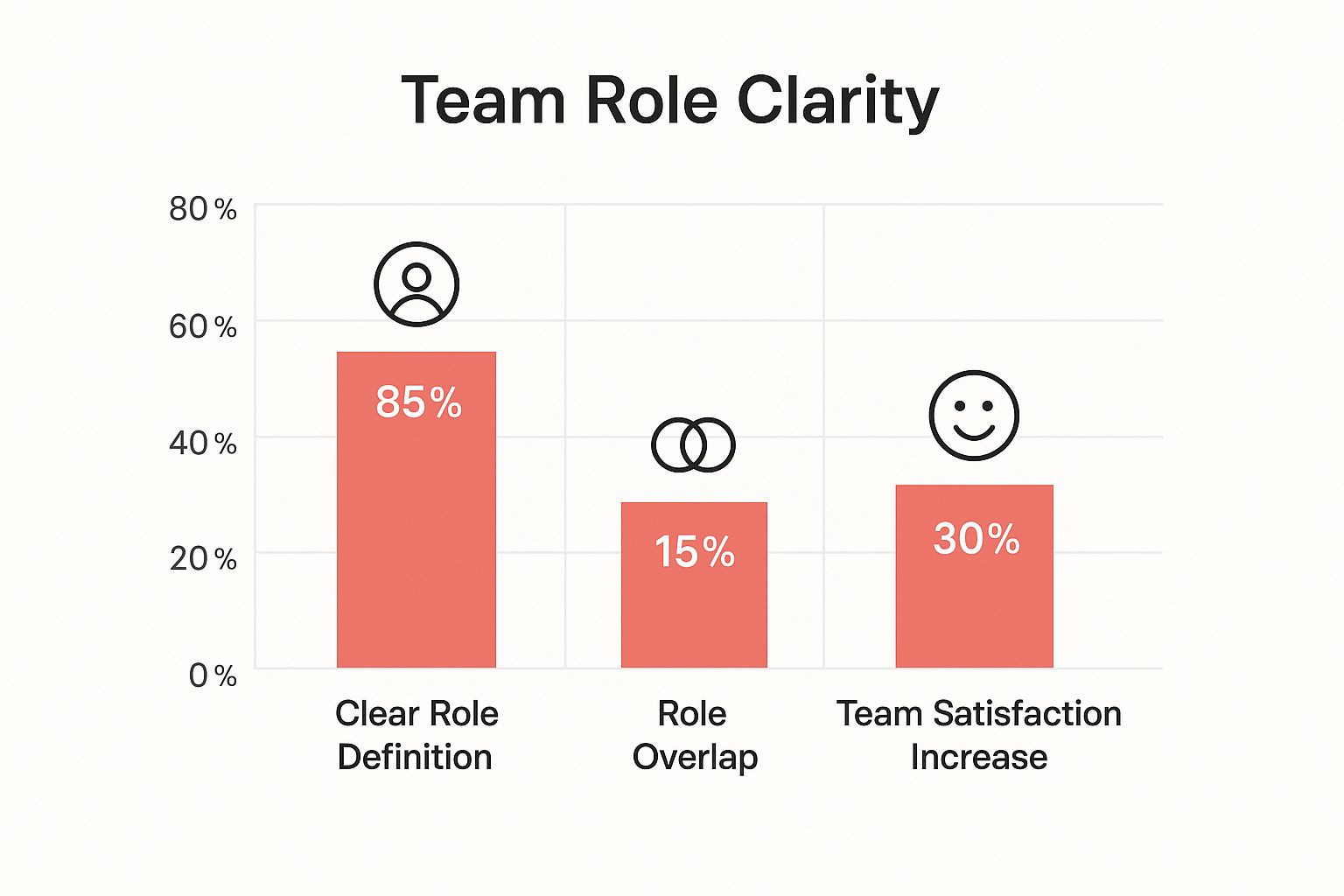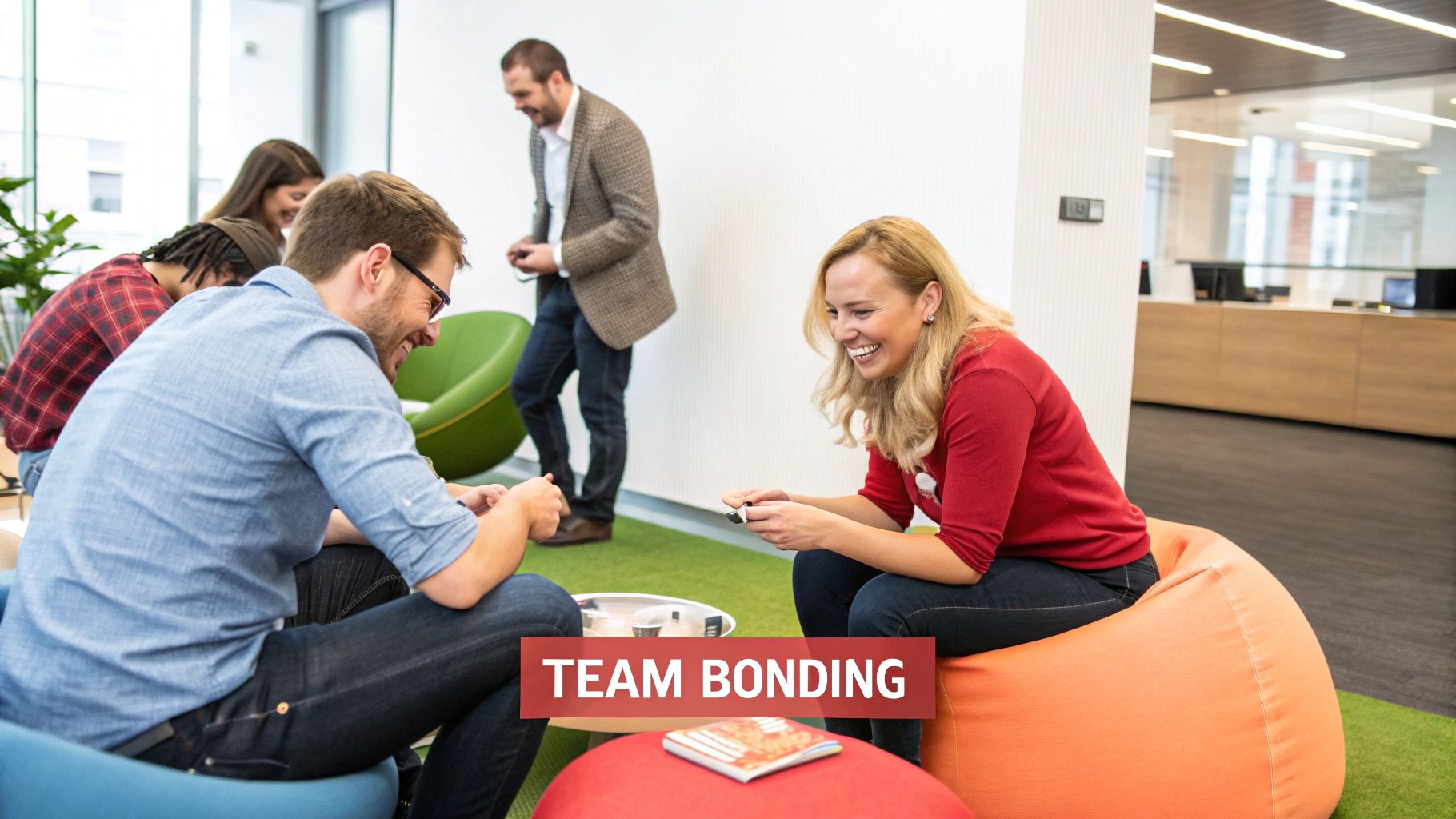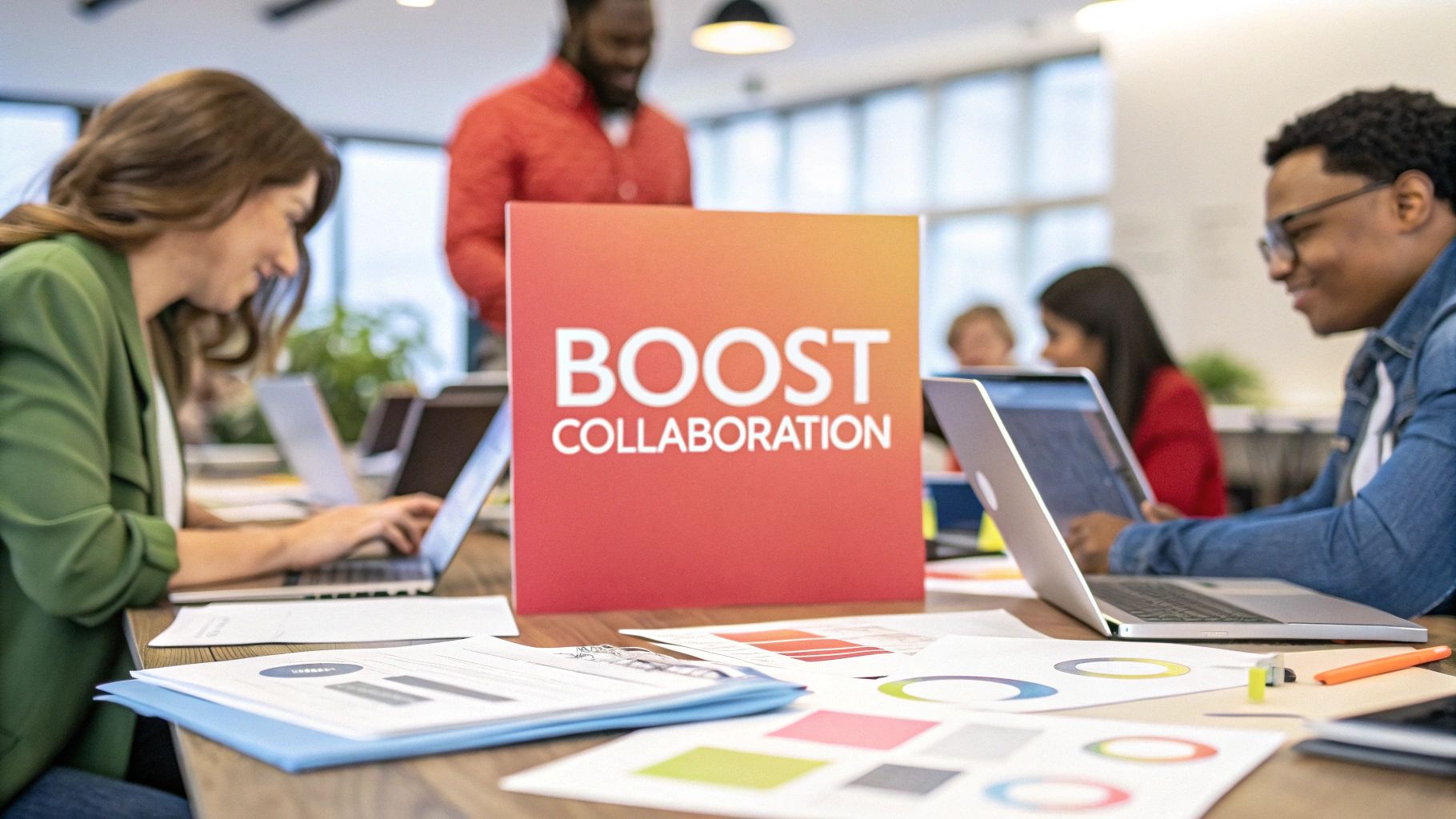For an agency to truly thrive, collaboration needs to be more than just a buzzword thrown around in meetings. It's the engine of your business, the very thing that separates a disjointed client experience from a seamless one. When your teams are in sync, the results aren't just noticeable—they're transformative.
Think about it. We've all seen what happens when collaboration breaks down. It's the difference between hitting deadlines with high-fives all around and constantly playing a frustrating game of catch-up.
Why Agency Collaboration Is Your Secret Weapon for Client Success
In a market this crowded, genuine collaboration is your most powerful competitive edge.
The stakes are uniquely high for agencies. A lack of synergy between your creative, account, and strategy teams almost always leads to predictable—and preventable—failures. I’ve seen it happen countless times: the sales team, eager to close a deal, promises a client a specific campaign feature without ever checking with the development team.
What’s the outcome? A client who feels misled, a development team scrambling under impossible pressure, and a project that’s already behind schedule on day one. This isn't just an internal headache; it's a slow leak that erodes your agency's reputation and bottom line.
The True Cost of Working in Silos to Your Agency's Bottom Line
When departments operate like isolated islands, critical information gets stranded. An account manager might have a game-changing insight from a client call, but if that nugget of gold never makes it to the creative team, the work is destined to miss the mark.
This creates a painful cycle of endless revisions, which blows through budgets and torpedoes timelines. Even worse, it leads to creative burnout, driving your best talent away.
The data doesn't lie. Research has clearly linked workplace collaboration to powerful business results. Companies that make teamwork a priority see a 27% increase in sales and a 30% boost in innovation. It even impacts your team's morale, contributing to a 17% rise in employee job satisfaction. You can dig into the full workplace collaboration statistics to see just how deep the connections run.
The most successful agencies don't just hire talented people; they build systems that amplify that talent. They know that a brilliant idea from a junior designer is worthless if it never reaches the project lead.
The Three Pillars of Unstoppable Agency Teamwork
So, how do you build a truly collaborative agency? It comes down to focusing your efforts on three core pillars. Mastering these creates a resilient framework that supports exceptional work, faster delivery, and a culture that people are excited to be a part of.
These aren't just abstract ideas. They are actionable areas where you can make real, tangible improvements.
To get started, it helps to understand these foundational elements and what they can do for your agency.
The Core Pillars of Agency Collaboration
By building on these three pillars, you're not just improving a process; you're fundamentally changing how your agency operates for the better. Let's break down exactly how you can implement each one.
Pillar 1: Designing Communication and Workflow Systems for Agency Clarity

Let's be honest. A chaotic system—or worse, no system at all—is a one-way ticket to project failure. When your team doesn't have a clear playbook for how to communicate or track work, crucial details are guaranteed to slip through the cracks. It's time to move from that operational ambiguity to a clear, functional blueprint.
This journey starts by taking a hard look at your existing channels. Where do conversations actually happen? Is it a messy mix of endless email threads, scattered Slack DMs, and random hallway chats? That kind of fragmentation is exactly where miscommunication thrives. In fact, one study found that a staggering 86% of workplace failures boil down to ineffective communication or a lack of real teamwork.
The goal here isn't to add more process for the sake of it. It's about building a predictable, efficient system that keeps everyone on the same page without leading to burnout. You need dedicated spaces for specific types of communication to finally cut through the noise.
Create Your Agency's Communication Charter
This sounds more formal than it is. A communication charter is really just a simple document that outlines which tool to use for which purpose. It's a team agreement that puts an end to the "Where should I post this?" guesswork.
Think of it as a user manual for how your agency team talks to each other. For instance:
- Slack: This is for urgent, real-time questions and quick, informal team announcements. It is not the place for deep project strategy or final client sign-offs.
- Asana/Project Management Tool: This becomes the single source of truth for anything task-related. All comments, deadlines, and file attachments tied to a specific deliverable live here. No exceptions.
- Email: Reserve this for more formal, external communication with clients, vendors, or partners.
- Scribbl: This is the dedicated hub for all your meeting intelligence. Summaries, key decisions, and action items from client calls or internal brainstorms live here, making those insights accessible to the whole agency.
This simple act of assigning a job to each tool is what stops critical client information from getting lost in the wrong channel. It provides the backbone for truly effective collaboration.
A well-defined communication charter doesn't restrict conversation; it directs it. By giving every message a home, you empower your agency team to focus on the work itself, not on hunting for information.
Standardize Your Agency's Key Project Workflows
Once your communication channels are sorted, the next step is to standardize your core agency workflows. Consistency is the bedrock of both quality control and your ability to scale. Two of the most critical workflows to lock down are project kickoffs and daily check-ins.
A standardized project kickoff process makes sure every new client engagement starts with complete alignment. From day one, everyone—from account managers to developers—knows the objectives, the exact scope, and what they're personally responsible for.
Likewise, agile-inspired daily stand-ups can be a game-changer. These aren't your typical long, soul-crushing status meetings. We're talking quick, 15-minute huddles focused on just three things: What did you do yesterday? What will you do today? Are there any blockers in your way? This format keeps momentum high and brings problems to the surface long before they can derail a client project.
For a deeper dive, you should explore these expert meeting facilitation techniques to make every single interaction more productive.
By building and documenting these systems, you create a reliable foundation for your agency team to operate on. This predictability frees up their mental energy to focus on what they do best: delivering incredible work for your clients.
Pillar 2: Building a Unified Tech Stack to Connect Your Agency
The tech you choose doesn't just support your agency's work; it actively shapes it. I’ve seen it time and again: agencies pick tools based on flashy features or whatever’s new, and they end up with a tangled mess. Instead of a smooth, connected system, they get a handful of platforms that don’t talk to each other. This traps critical information in digital silos and kills any chance of real team collaboration.
Think of your tech stack as the central nervous system for your agency. When it’s truly unified, information flows freely—from the initial client discovery call all the way to the final campaign report. This prevents that all-too-common nightmare where a brilliant idea from a brainstorming session evaporates because it was never logged as a task in your project management tool.
Choose Platforms That Actually Foster Agency Collaboration
The key is to look past the marketing hype and focus on how a platform fits into your agency's unique DNA. A tool that’s perfect for a five-person boutique firm will likely crack under the pressure of a 50-person agency juggling complex, multi-channel client accounts.
Before you even book a demo, ask your agency leaders these questions:
- Workflow Integration: Does this tool solve a specific problem we have right now? Avoid "solutions" that are just looking for a problem.
- Scalability: Can this thing grow with us? Consider its ability to handle more users, projects, and data as your client roster expands.
- Client-Facing Features: How does it help us work with clients? Features like dedicated client portals or easy-to-share progress reports are gold for building transparency and trust.
Turn Every Client Conversation into Actionable Tasks
The biggest gap I see in most agency tech stacks is the canyon between conversations and actions. You know the drill. Important decisions, client feedback, and fresh ideas get thrown around in meetings but never make it into your project management system as concrete tasks.
This is where a modern meeting intelligence platform like Scribbl becomes a game-changer. By automatically transcribing and summarizing your client calls, Scribbl makes sure no valuable insight gets lost in the shuffle. It acts as the bridge between your conversations on Google Meet or Zoom and your tasks in platforms like Asana or Monday.com, turning spoken words directly into assignable action items.
This connection between communication and productivity is powerful. It creates a workflow where talk immediately fuels action, which is exactly what the data shows high-performing teams do.

As you can see, there’s a clear link here. When teams have well-defined roles with minimal overlap—something a unified tech stack helps clarify and reinforce—their job satisfaction skyrockets.
The demand for these kinds of integrated tools is exploding. The global enterprise collaboration market is on track to hit around $85.8 billion by 2026, growing at a compound annual rate of 12.7%. This boom is driven by new tech, with 90% of companies aiming to blend AI with human intelligence to boost remote collaboration. You can dig into more of these workplace collaboration statistics and trends if you're curious.
Agency Project Management Tool Comparison
Choosing the right project management tool is a cornerstone of a unified stack. While many platforms offer similar features, their suitability for agency life can vary dramatically. Here's a quick look at how some of the top contenders stack up for agency-specific needs.
This table gives a high-level view, but the best choice always depends on your agency's specific workflows. If you value simplicity and visual planning, Monday.com might be your fit. If you need deep customization and an all-in-one platform, ClickUp is a powerhouse. And if you want a proven, task-focused system, Asana is a classic for a reason.
Your tech stack should be a bridge, not a series of islands. Every tool you add must connect seamlessly with the others to create a single, reliable source of truth for your entire agency.
Ultimately, building a unified tech stack is about making smart, strategic choices that erase friction and empower your team. By picking tools that play well together and fill critical gaps—like the one between conversations and tasks—you create an environment where collaboration isn’t just an ideal. It becomes a daily, operational reality.
Pillar 3: Fostering a Culture of Trust and Shared Ownership

You can have the most dialed-in project management system and a flawless communication charter, but your collaboration will eventually hit a wall without the right culture. The best processes in the world are only as good as the people executing them.
This is where the human side of teamwork really comes into play, starting with trust and psychological safety.
For an agency, this isn't just a "nice-to-have" — it’s the bedrock of great creative work and proactive problem-solving. When team members feel safe enough to voice a different opinion or flag a potential problem without fearing blame, you unlock a completely different level of performance.
Lead with Action and Accountability from the Top Down
Trust isn't built from mission statements hanging on a wall; it's forged in the daily actions of agency leadership. If you want your team to take ownership, you have to model it from the top down.
This means actively encouraging intelligent risks, even when they don't quite pan out.
Think about it. When a junior designer proposes a bold but risky campaign idea, is the gut reaction to shut it down or to get curious? When a project hits a snag, does the conversation immediately turn to "Who dropped the ball?" or "How can we solve this together?" This small shift is what turns a culture of blame into one of genuine shared accountability.
A team that feels psychologically safe is a team that innovates. When the fear of failure is removed, people are free to contribute their best, most creative ideas, which is the lifeblood of any successful agency.
Empower Every Voice on Your Agency Team
True shared ownership means every single person feels empowered to contribute, regardless of their job title. This doesn't happen by accident; you have to create deliberate spaces for it.
For example, when reviewing a project brief, don't just look to the senior members. Make a point to ask for input from everyone in the room. This inclusive approach has a direct, measurable impact on your agency’s creative output and efficiency.
In fact, a comprehensive study from Deloitte found that 73% of employees who frequently collaborate report improved performance. On top of that, 60% say it sparks their creativity. The data is clear: teamwork directly fuels both productivity and innovation.
This practice also sharpens your agency's decision-making. By including the people who will actually do the work, you ensure plans are grounded in reality. The same principle applies after the meeting is over. Creating clear, unbiased notes is crucial for keeping everyone aligned and reinforcing that their input mattered.
Our guide on how to write an objective summary offers practical tips for capturing meeting outcomes fairly, a small but powerful step in building trust. When people know their contributions are accurately recorded and valued, they're far more likely to invest themselves fully in a project's success.
Navigating Common Agency Collaboration Pitfalls and How to Fix Them

Even with the best systems and a great culture, real-world roadblocks can still pop up and derail your agency's collaborative groove. The first step to fixing these issues is spotting them in the wild.
These pitfalls often seem small at first—a fuzzy project role here, a mismatched client expectation there. But they have a nasty habit of snowballing, creating friction, rework, and blown deadlines. They're the silent killers of agency momentum.
The Problem of Ambiguous Project Roles and Responsibilities
One of the most common collaboration killers I've seen is role ambiguity. When people aren't 100% clear on who owns what, tasks get dropped and decisions grind to a halt. It’s the classic "I thought you were handling that" scenario, which leads to duplicated effort or, even worse, nothing getting done at all.
This isn't just a minor annoyance; it directly torpedoes project outcomes. A recent survey found that a whopping 86% of workplace failures come down to poor communication or a lack of teamwork. On top of that, 97% of employees feel that team misalignment sinks projects.
To get ahead of this, top-performing agencies often bring out a RACI matrix at the start of any big client project.
It’s a simple chart that makes responsibilities crystal clear for every key task:
- Responsible: The person actually doing the work.
- Accountable: The one person who owns the final decision and outcome.
- Consulted: Key people who need to provide input before the work is done.
- Informed: Folks who just need to be kept in the loop on progress.
Nailing down these roles from the get-go eliminates the guesswork and gives people the confidence to make decisions in their lane.
The Crippling Cost of Ineffective Client and Team Meetings
Another massive drain on agency life is the endless cycle of useless meetings. They’re supposed to create alignment but often turn into black holes for time and energy, leaving everyone more confused than when they started.
The issue usually boils down to a lack of structure and purpose. A meeting without a sharp agenda, clear goals, and a designated facilitator is doomed to meander. This doesn't just burn through billable hours; it breeds cynicism and makes your team dread the very idea of collaboration.
An agency's most valuable asset is its team's time and focus. Every meeting that ends without clear action items is not just a wasted hour; it's a direct withdrawal from your agency's creative capital.
This is why strict meeting hygiene is non-negotiable. Every calendar invite needs a clear agenda and must state the meeting's primary goal. Afterwards, a summary with documented decisions and assigned action items has to be sent out quickly. This simple discipline turns meetings from time-wasters back into productive work sessions.
For a deeper dive, our guide on meeting management best practices has more strategies you can put to work.
Frequently Asked Questions About Improving Agency Collaboration
Let's dig into some of the most common questions I hear from agency leaders trying to get their teams working better together. These are the real-world hurdles that pop up when you start to get serious about improving collaboration.
How Can We Improve Collaboration with Our Agency's Remote or Hybrid Teams?
When your agency team is spread out, the secret isn't more meetings—it's better asynchronous communication. You have to build systems that don't require everyone to be logged on at the exact same moment to get work done.
Start by obsessively documenting your core processes. Your project management platform should be the absolute single source of truth, housing all project info, client assets, and communications. No side conversations in DMs.
I'm a huge fan of using short, pre-recorded video messages (like Loom) for things like status updates or feedback. This kills the need for so many sync-up meetings and saves that precious real-time availability for what truly requires it: deep strategic thinking, complex problem-solving, and just connecting as a team.
What Is the Single Biggest Mistake Agencies Make with Collaboration Tools?
This one's easy. The most common pitfall is falling for a shiny new tool before you've clearly defined the problem and the process it's supposed to improve. It's a recipe for disaster that usually ends with low adoption, more confusion, and another unused software subscription.
Always map out your ideal workflow on paper first. Where is the friction? What does a perfect, smooth process actually look like for your agency? Only after you've defined that should you go looking for a tool that fits your process. Never the other way around.
The goal is to find technology that supports your workflow, not to change your workflow to fit a piece of technology. Always get team buy-in on the process before you even start a software trial.
How Do We Get Client Buy-In for Our New Collaborative Processes?
Getting clients to adopt your new way of working is all about framing the benefits for them. Forget talking about your internal efficiency; they don't care about that. They care about what's in it for them.
You have to position your new, structured process as a direct upgrade to their experience. For example:
- "You get total transparency." Show them how a client portal gives them 24/7 visibility into exactly where their project stands.
- "We can act on your feedback faster." Explain how centralizing comments in one place means their notes get seen and addressed immediately.
- "This helps us deliver on time, every time." Clarify how your organized workflow leads to more predictable timelines and better budget management.
The best time to introduce these new systems—like a shared dashboard or a dedicated comms channel—is during the client onboarding process. Make it part of how you work from day one. When you clearly show how your improved collaboration leads to better results for their business, they won't just accept it; they'll love it.
Ready to turn every client conversation into clear, actionable insights for your entire team? See how Scribbl automatically summarizes your meetings, identifies key tasks, and integrates with your existing tools to create a seamless collaborative workflow. Discover a smarter way to work at https://www.scribbl.co.




